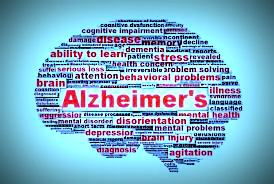Alzheimer’s Disease: Diagnosis
 Dementia is a progressive deterioration of intellectual functions due to a brain disease, organ failure or malfunction, drug toxicity or other causes. In western countries, Alzheimer’s disease accounts for about half of all dementia cases. At present, the only way to definitely diagnose Alzheimer's is through a brain autopsy. If the person exhibited Alzheimer-like symptoms while alive and the brain tissue contains the microscopic physical abnormalities typical of Alzheimer's disease, then a definitive diagnosis can be made. While a person is alive, physicians can correctly diagnose Alzheimer's disease about 90 percent of the time based on mental and behavioral symptoms, a physical examination, neuropsychological tests and laboratory tests.
Dementia is a progressive deterioration of intellectual functions due to a brain disease, organ failure or malfunction, drug toxicity or other causes. In western countries, Alzheimer’s disease accounts for about half of all dementia cases. At present, the only way to definitely diagnose Alzheimer's is through a brain autopsy. If the person exhibited Alzheimer-like symptoms while alive and the brain tissue contains the microscopic physical abnormalities typical of Alzheimer's disease, then a definitive diagnosis can be made. While a person is alive, physicians can correctly diagnose Alzheimer's disease about 90 percent of the time based on mental and behavioral symptoms, a physical examination, neuropsychological tests and laboratory tests.
An evaluation to diagnose Alzheimer's disease consists of several parts: taking a recent history of mental and behavioral symptoms; a physical examination; and neuropsychological tests.
 The physician will normally take a history of mental and behavioral symptoms, using information provided by the patient and the family. In nearly 75 percent of cases, Alzheimer's starts with the inability to remember recent events and to learn and retain new information. Early stage patients experience memory problems that interfere with daily living and steadily worsen. Other early symptoms can include difficulty managing money, driving, orientation, shopping, following instructions, abstract (conceptual) thinking and finding the right words. There may also be other problems, such as poor judgment, emotional instability and apathy. Alzheimer's disease can be distinguished from other types of dementia in part by the symptoms exhibited, the extent to which these symptoms occur and the speed with which the disease progresses.
The physician will normally take a history of mental and behavioral symptoms, using information provided by the patient and the family. In nearly 75 percent of cases, Alzheimer's starts with the inability to remember recent events and to learn and retain new information. Early stage patients experience memory problems that interfere with daily living and steadily worsen. Other early symptoms can include difficulty managing money, driving, orientation, shopping, following instructions, abstract (conceptual) thinking and finding the right words. There may also be other problems, such as poor judgment, emotional instability and apathy. Alzheimer's disease can be distinguished from other types of dementia in part by the symptoms exhibited, the extent to which these symptoms occur and the speed with which the disease progresses.
A physical examination will be performed to help identify and rule out other potential causes of dementia. This exam will normally include a general physical, blood tests and urinalysis. Through a blood test, for example, the physician can measure thyroid function; hypothyroidism or failure to produce sufficient thyroid hormones, which is common in the elderly and can cause dementia. Dementia may also be the result of a vitamin B12 deficiency, a condition common in older people. A vitamin B12 deficiency can be measured through blood tests. Physicians may use brain scans (such as magnetic resonance imaging or MRI) to rule out other possible causes of dementia, including brain tumors, stroke, blood accumulation on the brain surface or other conditions. In addition, brain scans can show characteristic structural changes present in Alzheimer's disease. Physicians may administer an electroencephalogram (EEG) to measure the electrical activity in the brain. Occasionally, spinal fluid may be tested through a lumbar puncture.
Neuropsychological tests identify behavioral and mental symptoms associated with brain injury or abnormal brain function. The neuropsychological tests used will depend on the symptoms and the dementia’s state of advancement. Usually, physicians start with a brief screening tool, such as the Mini-Mental Status Examination (MMSE), to help confirm that the patient is experiencing problems with intellectual functions. The MMSE includes tests of memory, attention, mathematical calculation and language. If a patient has severe dementia, further neuropsychological testing beyond the MMSE is usually not necessary. However, for patients with mild intellectual deficits, more tests may be needed to determine whether the patient is simply showing signs of advanced age or is developing Alzheimer's disease. The patient may be referred to a neuropsychologist, who will administer a battery of tests to identify more specific deficits.
Many scientists are researching new ways to inexpensively and reliably diagnose Alzheimer’s disease earlier and with more accuracy. Some research on better diagnosis focuses on personality changes and cognitive functioning, measured through memory and recall tests. Such tests might point to early Alzheimer’s or predict which individuals are at higher risk of developing this disease in the future. Other studies are examining a correlation between early brain damage and outward clinical signs. Researchers are also looking at changes occurring in the blood and cerebrospinal fluid that may indicate the progression of Alzheimer’s disease.